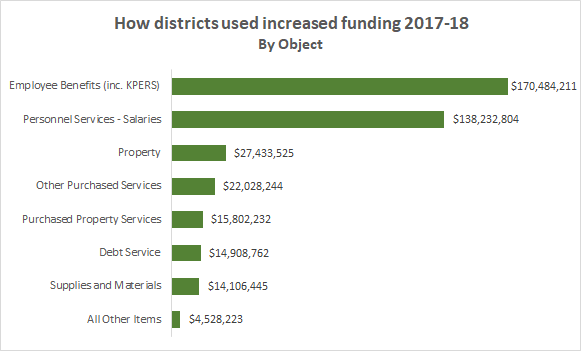Kansas’ investment in public education has been growing much
slower than total income of Kansas residents and spending on most personal
goods and services since 2010, according to new data from the Bureau of
Economic Analysis. (Link)
The decline occurred as Kansas per pupil funding has fallen
behind inflation and other states. There is a strong, positive correlation between
education funding, educational attainment, higher state average income and lower
poverty rates. (See previous posts on funding
and the link between education
and economic prosperity.)
The BEA annually reports personal consumption expenditures
by state, defined as “goods and services purchased by or on behalf of
households and the net expenditures of nonprofit institutions serving
households (NPISHs) by state of residence for the 50 states and the District of
Columbia.” (These figures do not include increased funding for school districts
beginning in 2017-18 because income and spending data is not yet available.)
KASB compared Kansas personal consumption expenditures with
total Kansas personal income and total expenditures on K-12 education by Kansas
school districts as reported by the Kansas State Department of
Education.
Between 2010 and 2017, Kansas personal income increased from
$112.1 billion to $141.5 billion, or 26.2 percent. Personal consumption expenditures
increased from $86.1 billion to $106.4 billion, a slightly lower rate of 23.7
percent.
Total school district expenditures increased from $5.5
billion to $6.1 billion, or 8.8 percent. School expenditures dropped from 5.0
percent of Kansas personal income in 2010 to 4.3 percent in 2017.
The 8.8 percent increase in K-12 expenditures between 2010
and 2017 was lower than any category of personal expenditures except for gasoline
and other energy goods, which decreased 2.6 percent 2010 and 2017.
Expenditures on Financial Service and Insurance (37.2
percent), Food Services and Accommodations - dining out and lodging (31.6
percent), Housing and Utilities (29.0 percent), Recreational Services (28.9
percent) and Motor Vehicles and Parts (28.0 percent) increased faster than
Kansas personal income.
Expenditures on Furnishing and Household Equipment (26.0 percent),
Transportation Services (23.1 percent), Recreation Goods and Vehicles (21.8
percent), Health Care Services (21.5 percent), Food and Beverages Consumed at Home
(16.7 percent) and Clothing (10.1 percent) increased less than personal income
but more than K-12 expenditures.
The amount of spending on K-12 educational also ranks low
compared to major personal expenditure categories. Kansas spent $21.9 billion
on Housing and Utilities in 2017, $18.7 billion on Health Care Services, $17.7
billion on Financial Services and Insurance, $10.1 billion on transportation
services, vehicles and fuel, $8.7 billion on Food and Beverages at home, $7
billion on recreational good ands services and $6.3 billion on Food Services
and Accommodations (dining out and lodging), compared to $6.1 billion on K-12
education. Only Clothing and Footwear, at $2.7 billion, was lower than school
district spending.
This data indicates that Kansas expenditures on public
education have actually been a declining share of total income by Kansas since
2010, and that other categories of expenditure have growing faster than
education funding. In fact, that has been true as far back as 2000. Since 2000,
K-12 expenditures increased 74.6 percent, personal consumption expenditures
78.6 percent and Kansas personal income 84.9 percent.
There would be no problem spending less on K-12 education
and more on personal goods and services if Kansas were getting the education
results they want and need, and/or if funding made no difference in educational
results. However, Kansas education funding has fallen behind inflation and
other states, as have Kansas average teacher salaries. Although Kansas ranks
above average national and regionally in educational outcomes, other states
have been increasing funding more and improving results faster.
To meet future employment needs and compete with other
states, Kansas needs to graduate more students from high school and
postsecondary education. The states with the highest educational outcomes tend
to spend more per pupil than most states, already spend more than Kansas; and
have higher personal income and lower poverty rates. If Kansas continues to
spend less on K-12 education, it will ultimately mean less personal income to
spend on everything else.
There is another impact of personal expenditure changes.
Since 2000, spending on “goods” has increased by 56.1 percent and spending on
“services” increased 92.5 percent. Because the Kansas sales tax is generally
applied to goods and not to services, this shift in consumption from goods to
services is one major reason state revenues have been growing more slowly, and
why lowering state income tax rates and relying more heavily on consumption
taxes that do not includes services will likely further reduce revenues for public
services like K-12 education.
Definitions:
Total personal income is the income received by, or on
behalf of, all persons from all sources: from participation as laborers in
production, from owning a home or business, from the ownership of financial
assets, and from government and business in the form of transfers; from
domestic sources as well as the rest of world. It does not include realized or
unrealized capital gains or losses.
Essentially, the difference between personal income and
consumption expenditures is the total of taxes paid, personal interest payments
and transfer payments to governmental programs such as social security, and
personal savings.
Total K-12 expenditures is all spending by Kansas school
districts, including state, federal and local funding. Most of this revenue is
from taxes, but a portion is personal payments, such as lunch fees and charges
for student materials and transportation.




















